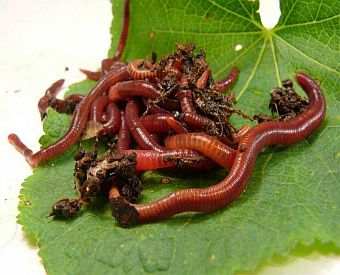Red worms: Where to buy them
Everything You Required to Know Concerning Red Wigglers for Composting
Red wigglers, or Eisenia fetida, play a critical role in the realm of composting, transforming organic waste into useful dirt modifications. Their unique biological qualities allow them to thrive in various problems, making them an optimal choice for both beginner and seasoned composters alike. Recognizing their requirements and advantages is crucial for developing an efficient vermicomposting system. The procedure of setting up a worm container and keeping it can present difficulties. To efficiently harness the possibility of these worms, one must explore the complexities of their care and administration.
What Are Red Wigglers?

(Lake James Bait)
Belonging To The United States and copyright, red wigglers are surface-dwelling microorganisms that choose damp, cozy environments abundant in disintegrating raw material. Their diet consists largely of decaying plant product, food scraps, and various other natural particles, which they take in and break down successfully. As they digest this product, they generate nutrient-rich spreadings that improve soil fertility.
Red wigglers are hermaphroditic, possessing both male and female reproductive body organs, and can replicate swiftly under optimum problems. Generally, red wigglers are crucial contributors to the process of reusing organic waste right into useful garden compost.
Advantages of Utilizing Red Wigglers
Utilizing red wigglers in composting systems uses numerous advantages that boost both the effectiveness of waste management and the high quality of the resulting compost. These worms, scientifically called Eisenia fetida, are especially effective at breaking down natural matter, turning kitchen area scraps and backyard waste right into nutrient-rich garden compost at an increased rate.
One of the key benefits of utilizing red wigglers is their capacity to eat huge quantities of organic product, typically refining their weight in food waste daily. This high intake price leads to quicker disintegration and lowers the volume of waste sent to garbage dumps. Furthermore, the castings generated by red wigglers are abundant in vital nutrients, advantageous microbes, and enzymes, making them a superb plant food for yards and plants.
Additionally, red wigglers thrive in a range of atmospheres, making them versatile for both interior and exterior composting systems - red wigglers. Their presence in a garden compost container assists to aerate the product, avoiding odors and promoting a healthy composting procedure. Generally, employing red wigglers not only adds to reliable waste monitoring however also supports sustainable gardening techniques through the production of premium compost
(red wiggler worms)
Setting Up Your Worm Container
To effectively set up a worm bin, it is vital to pick a suitable container that meets the demands of red wigglers while try this out offering a favorable environment for composting. An ideal bin can be made from plastic, timber, or steel, with an ability of a minimum of 1 square foot for every pound of worms.
Make certain the container has adequate water drainage holes to avoid excess wetness, as red wigglers prosper in a moist, however not water logged, environment. red wigglers. The bin must also be aerated to supply enough air movement, preventing anaerobic conditions that might harm the worms
A suitable area for the worm container is a cool, dark area, without straight sunshine and extreme temperatures, as red wigglers favor a temperature level array of 55 to 77 degrees Fahrenheit.
Prior to presenting the worms, prepare bedding materials such as shredded newspaper, cardboard, or coconut coir, which will certainly supply both habitat and food. Dampen the bedding gently to develop a welcoming atmosphere for the worms. Last but not least, think about positioning a lid on the container to keep moisture and minimize parasites, while ensuring it can be easily gotten rid of for upkeep.
Feeding and Care Guidelines
Feeding red wigglers is a crucial element of maintaining a healthy and balanced composting system. These worms flourish on a diverse diet plan, mainly made up of organic materials such as fruit and veggie scraps, coffee grounds, and smashed eggshells. It is necessary to avoid feeding them meat, dairy, and oily foods, as these can develop undesirable odors and attract pests.
When presenting food to your worm bin, chop or shred materials right into smaller sized pieces to promote quicker decomposition. Begin with percentages to evaluate the worms' intake rate, progressively increasing the quantity as they adapt. It is advisable to alternative feeding places within the bin to encourage comprehensive blending and oygenation of the compost.

Troubleshooting Common Issues
Maintaining a prospering worm composting system can occasionally provide obstacles that need focus and troubleshooting. Common issues include an undesirable smell, which frequently suggests overfeeding or the presence of anaerobic conditions. To treat this, decrease the amount of food included and make certain proper oygenation by mixing the bed linens material.
Another frequent issue is the retreat of worms from the bin. This can happen due to extreme wetness or improper ecological conditions. Regularly check the wetness levels, going for a damp but not soggy uniformity, and maintain ideal temperatures in between 60-80 ° F(15-27 ° C )to create a comfy habitat for your red wigglers.
Parasites, such as fruit flies, can likewise invade worm bins. red wigglers. To battle this, cover food scraps with a layer of bedding or shredded paper to discourage flies from laying eggs. Additionally, ensure that any kind of food included is fresh and without mold and mildew, which can draw in undesirable insects
Finally, if your worms appear inactive, check for stress aspects such as temperature level changes or poor dampness. Addressing these usual issues will help preserve a healthy and productive worm composting system.
Final Thought
In recap, red wigglers, or Eisenia fetida, play a vital duty in sustainable waste administration via vermicomposting. Correct configuration and maintenance of a worm bin, along with adherence to feeding guidelines, make certain a growing environment that reduces garbage dump payments.